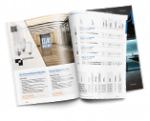Hold on and feel good at home.
Our hints for good lighting.

We are still encouraged to spend as much time as possible within our own four walls due to current contact restrictions. This makes it all the more important that we feel comfortable at home - whether inside the house or outside on balcony or terrace.
That's why many people are already busy with renovation or gardening work to make their homes really cosy. Because for many of us, our homes are now also our workplaces, schools, restaurants, cafés, playgrounds or shopping centres. Reason enough to think about the right lighting as well. After all, light can make the surroundings get in a wide variety of moods.
So that you don't have to start from scratch when optimising your lighting, we have a few useful hints for you here:
Use daylight.
Still and always the best source of light is the sun. It provides us with the right dose of light at any time of day. Especially now that summertime is approaching, daylight can be used all the better and for longer periods of time.
Position your desk properly.
For good lighting at your workplace, it is important to avoid glare but still have enough light in your field of vision. To do this, position the desk sideways to a window so that you do not have to look directly into the window and the window is not at your back. This way, the light reaches your workstation and your eyes are not tired out by strong changes in contrast.
Adapt the amount and colour of light to the situation.
At times when you are active, you need a lot of light. Cooler light colours (4000 - 6500 Kelvin) also help to let your body know that you need to concentrate and stay awake. A simple lamp change can make a big difference. Try a different colour temperature and simply use a brighter lamp than usual.
In the evening, however, you should dim the light or use darker light sources so that your body can relax. Here, cooler light sources should no longer be active. It is best to use warm light colours with around 2700 Kelvin. Many dimmers can be easily installed at a later date to create the right mood with a suitable, dimmable lamp.
Many smartphones and tablets do also have a standard function that adjusts the colours of the display accordingly (called "night shift" or "night mode" depending on the manufacturer).
By the way: Light colour and brightness can be easily adjusted with our LED Strip WarmDIM. You can find out more about this here.
Note:
The light colour or colour temperature is given in Kelvin (K):
The higher the value, the cooler the colour of the light.
~ up to 3000K = warm white
~ 4000K = Neutral white
~ 6500K = cool white
Brightness ("luminous flux") is measured in lumens (lm):
The higher the luminous flux, the brighter the light.
~ up to 500lm = rather weak light, e.g. well suited for decorative lighting or reading lighting at short distances
~ 500-900lm = medium-intensity light source, e.g. well suited for general lighting in living rooms
~ 900lm and above = bright light, e.g. well suited for task lighting or in larger rooms
(Examples serve only as a rough guide. The actual brightness depends, among other things, on factors such as the number and positioning of the light sources and the type of luminaire).
Many "weak" light sources instead of one "strong" one.
Most people will do this quite intuitively: a ceiling light here, a table luminaire there and a few candles or a chain of lights. And that is exactly right. By using many light sources, you avoid too many differences in brightness and you have more possibilities to adapt the light to the situation. LED strips are also ideal for backlighting, accent lighting or orientation lighting. The flexible LED strips allow you to creatively and easily set a few fresh accents.
Find the right position.
Place the luminaires where you want them to be and orient the light. If you use a ceiling spot, then you should also aim at something with this spot. Illuminate objects or walls, pictures or flowers. Position the luminaires in the immediate vicinity of the desired application. A ceiling light in the middle of the room will not be able to provide you with the light you need on the worktop, as you will create a shadow yourself that way. In this case, install the light under the wall cupboards, for example. A floodlight shining directly into your eye in the outdoor area will not help either. So, take enough time before installation to consider how the light source is positioned best.
Perhaps you are currently still using halogen or energy-saving lamps that you could replace with long-lasting and efficient LED products? LEDs have a much longer life and save a lot of money as energy costs. With our LED's Save calculator you can easily calculate your individual cost savings. Take a look at www.radium.de/en/service-tools/leds-save.

